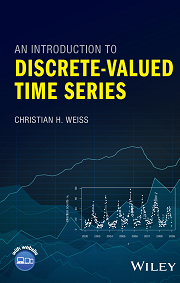A time series is a chronologically ordered sequence of observations, which is assumed to be part of the realization of an underlying stochastic process. To be able to predict future values, or to monitor the ongoing process with the aim of uncovering structural changes as soon as possible, the modeling of the process is of utmost importance, which, in turn, requires an in-depth statistical analysis of the available time series.
Since the pioneering textbook by Box & Jenkins (1970), time series analysis has become a well-established discipline in research, teaching and applications. For most of the time, however, a time series was automatically assumed to be real-valued, and textbooks about time series analysis deal with this case nearly exclusively even nowadays. In applications, in contrast, one is often confronted with time series consisting of discrete observations, such as count time series or even qualitative time series having a nominal or ordinal range. In such cases, the common models and methods for real-valued time series cannot be used.
Only during the last 25 years, there was a steadily increasing interest in research and practice concerning discrete-valued time series. Several models and approaches for statistical analysis of diverse types of discrete-valued time series have been developed since that time.
Introductory textbook about discrete-valued time series:
John Wiley & Sons, Inc.,
Chichester, 2018.
304 pages, hardcover.
ISBN 978-1-119-09696-2
Christian H. Weiß
An
Introduction to
Discrete-Valued
Time Series
Open-access survey article in “WIREs Computational Statistics”:
Weiß, C.H.: Stationary Count Time Series Models.
Accepted for publication in WIREs Computational Statistics, 2020.
Contributions to the encyclopedia “Wiley StatsRef”:
In 2018, five articles about discrete-valued time series appeared in the encyclopedia Wiley StatsRef: Statistics Reference Online (Balakrishnan et al. (eds.), John Wiley & Sons Ltd):
- Categorical Time Series Analysis
- Count Time Series Analysis
- Integer-valued Autoregregressive Moving-Average (INARMA) Models
- INGARCH and Regression Models for Count Time Series
- Hidden-Markov Models for Count Time Series
Letzte Änderung: 23. February 2025

